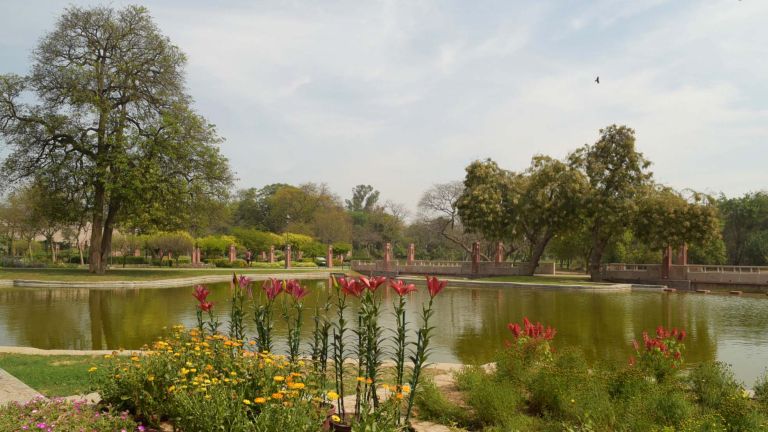You have to agree that when it comes to nature and greenery, Delhi fares better than a lot of other urban hubs. And in every nook and corner, you’ll find some beautiful park or a green patch. And one such hidden gem in the city is Sunder Nursery. Prominently visible from the famous Humayun’s Tomb, Sunder Nursery is one of the best gardens of Delhi with an abundance of trees, flowers and monuments. It was also a UNESCO World Heritage Site in 2016. Having been under renovation for the last 10 years, this picturesque nursery was opened to the public in 2018. Scroll down for more deets!
All About Sunder Nursery

Image Source: Wikipedia.com 
Image Source: Akdn.org
Originally called Azim Bagh built by the Mughals in the 16th century, this heritage park complex is adjacent to the Humayun’s Tomb. Spread over 90 acres, Sunder Nursery was later used by the British to grow exotic plants which gave it the name of ‘nursery’. And the word ‘Sunder’ came from the Sunder Burj tomb located on the same premises. The renovations started in 2007 and were reopened to the public in February 2018. Currently, it contains over 300 types of trees, making it Delhi’s first arboretum.

The Sunder Nursery is a part of the more significant Nizamuddin Urban Renewal Project of the Aga Khan Trust master plan that involves restoration work on 30 heritage structures. The Renewal Project wants to develop a corridor connecting Humayun’s Tomb and Sunder Nursery to Purana Qila and Zoo. Also, the future plan of the nursery is to link all the nearby areas and develop it into India’s largest park covering 900 acres.
Monuments To Check Out

Image Source: Instagram/ruharoma 
Image Source: Instagram/vats.bharat4u
The heritage compound has 12 monuments designated as World Heritage Sites by UNESCO, 6 of them are in Sunder Nursery: Sunder Burj, Lakkarwala Burj, Mirza Muzaffar Hussain’s Tomb, Sunderwala Mahal, Chhota Batashewala and the Unknown Mughal’s tomb. It also boasts of lotus-shaped fountains and two 16th century gumbads, Sunderwala Burj and Lakkarwala Burj. Recently, these gumbads have been freshly painted and restored and look beautiful with colourful flowers all around them.
An Iconic Spot To Check Out Flora And Fauna

Image Source: Instagram/shubhamguptapurwar 
Image Source: Instagram/brieloskota
Photographers, this is the best place in the city where you can get all the stunning pictures. Even nature lovers will adore this place! The area contains 4500 trees (yes!) and 54 varieties of flowers. Apart from this, there are around 80 different types of bird species and 36 types of butterflies. Their Bonsai House is home to some bonsai over 80 years old.
Talking about the variety of trees and plants found here includes Psidium Guajava (Guava), Dilienia Indica (Elephant Apple), Dalbergia Sissoo (Rosewood), Casuarina equisetifolia (Australian Pine Tree), Markhamia Lutea (Bright Yellow Flowers) and more. You can’t miss on their stunning rose collection that has been displayed all together at the rose garden. You will find the variety of roses like Michael LIS, Tata Pink, Iceberg, Black Pearl, Pristine, Gold Media, Broadway.

Image Source: Instagram/nafeezacantik 
Image Source: Instagram/seemakohli
In the area, 80 different species of birds can be spotted easily. In the year 2014, the rare Ultramarine Flycatcher was located, it’s a bird that has never been spotted in many years. The birds that can easily be spotted include Green Bee-eater, Coppersmith Barbet, Asian Pied Starling and Indian Silverbill. And to name a few butterflies, the nursery hosts Blue Pansy, Pioneer, Plain Tiger, Tiny Grass Blue and White Arab.
Drop everything and visit this lush green heritage site on a cosy morning to bask in its beauty and have a sunny picnic with your family and loved ones.
Where: Nizamuddin, adjoining Humayun’s Tomb, Nizamuddin West, New Delhi
(Featured Image Source: Reddit)




